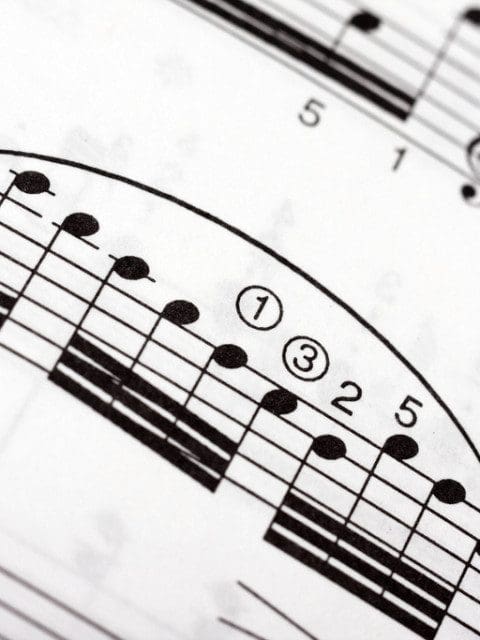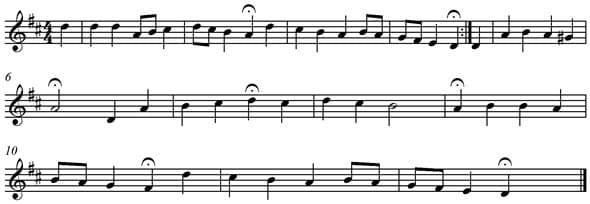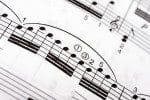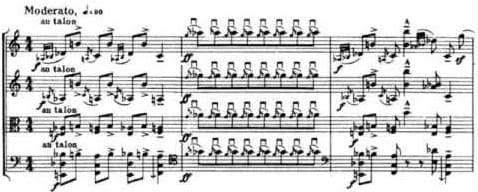 Many people say melody — the foreground sequence of pitches — is an essential part of music, but lots of music does just fine without any pitches. Even music that uses notes often doesn’t have melodies. So how does music operate when it does not have melodies?
Many people say melody — the foreground sequence of pitches — is an essential part of music, but lots of music does just fine without any pitches. Even music that uses notes often doesn’t have melodies. So how does music operate when it does not have melodies?
One way music works without melodies is through gestures. Gestures can look like melodies, and melodies are themselves gestures, but the two are distinct.
So what’s the difference?
This is Melody
When we talk about melodies we’re taking about how pitch, supported by rhythm, comprises motivic patterns, creates formal patterns and guides voice leading.
This is the melody for “A Mighty Fortress is Our God” (click on the score to listen):
- It is a series of pitches with fixed rhythms.
- It contains motives, such as the two eighth note/quarter note figure in the second half of bar 1. You see that same rhythmic figure two more times in the first line and a few more in the last one.
- It has a formal pattern: the first four bars repeat followed by a contrasting middle section and a return of the second half of the initial bars. You could diagram this form as AABA’.
- Among other things that could be said about the voice leading, the combination of pitches and rhythms guides your ear from the upper D to the lower D.
This is Gesture
In contrast, when we talk about gestures, we’re talking about how dynamics, rhythm and timbre, supported by pitch (mostly for its color or its shape), convey a distinct character.
This is a gesture from Béla Bartók’s Sixth String Quartet (click on the score to listen):
- Note how specific Bartók is about dynamics, timbre and articulation.
- Note, too, how pitch plays only a supportive role: in bars 1-2 we hear a zig-zag followed by a series of pings. We hear the color the pitches provide but we probably couldn’t sing them without lots of practice.
- Most importantly, as Bartók develops this gesture through the rest of the movement, (if you listen to it) you notice how this specific rhythmic character and shape change very little, even as he plays with other variables.
Contrasting Melodies and Gestures
With these definitions in mind, here’s how the distinctions between them play out:
- Melodies don’t need explicit dynamics or timbre to function, whereas gestures often do.
- Melodies don’t need involved, unique rhythmic profiles to be distinct, whereas gestures do.
- Melodies can be easily differentiated even if they last for the same number of bars, whereas gestures are easier to distinguish when, along with their other specific features, they are different lengths.
- Melodies can be set in a variety of textures. In contrast, gestures regularly incorporate entire textures. Such gestures would lose much of their identity translated to another texture.
- Melodies are often whole in themselves (think strophic form), whereas gestures are often fragments of form.
Traditional Western music usually thinks about gestures in terms of other parameters. For instance, when we talk about the gesture of a melody, we’re talking about its shape, its rhythmic features and its harmonic setting. To the extent that composers retain these features, we hear variations relating to the same source, regardless of surface differences. This understanding of melody as gesture underlies centuries worth of techniques and discussion about variation — little of which explicitly references “gesture.”
In contrast, twentieth-century composers often made it the main event. Many of them focused their efforts on creative ways to generate unique gestures or systematic ways to analyze music in which melody is downplayed or nonexistent in favor of gestures.
Yet in both eras you find examples of both paradigms.
For instance, in the first movement of Beethoven’s Eroica Symphony, the sforzando chords are a good example of gesture. They’re a very specific sound (tutti, loud) with a distinct rhythmic character (often, to disrupt the meter), and this gesture is just as critical to the character of movement as the melodies themselves.
Likewise, in that same Bartók string quartet, you find examples of melody. (Just keep listening past the example, or start the video from the beginning.)
Thus, understanding the difference between melodies and gestures unlocks a better appreciation of music from all eras.
Sign up to stay in the loop about my music—and ideas for your own composing!



